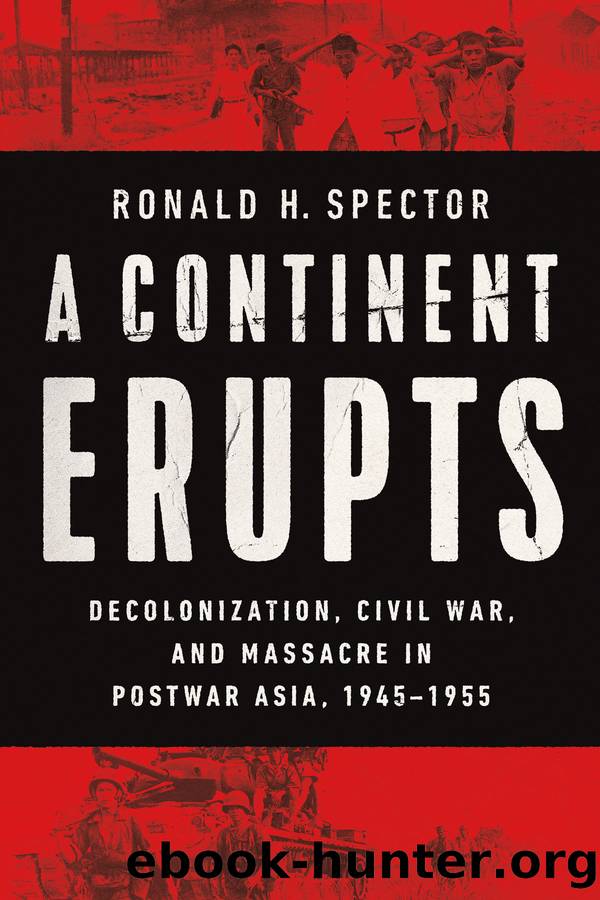A Continent Erupts by Ronald H. Spector

Author:Ronald H. Spector [Spector, Ronald H.]
Language: eng
Format: epub
ISBN: 9780393254662
Publisher: Norton
Published: 2022-07-18T00:00:00+00:00
13
âI Shall Crush Themâ
During the final days of the battle for the Pusan Perimeter, General Walker spent almost as much time worrying that General MacArthur might withdraw the Marine Brigade as he did about meeting North Korean attacks and probes. Since the arrival of the first US combat troops in Korea at the beginning of July, MacArthur had been planning a surprise amphibious assault at the port of Inchon, on the east coast of Korea only about twenty miles from Seoul. Such an attack would hit the rear of the North Korean forces in the South and sever their supply lines. For this operation, initially labeled âBlue Hearts,â MacArthur would require an entire Marine division plus at least one army division.
MacArthur notified the Joint Chiefs of Staff of his plans for an amphibious assault on July 23, even before he had received the chiefâs reluctant approval for two more Marine regiments to join his command. Together with the Marines already fighting at Pusan, the added two would comprise a full division, the First Marine Division, under Major General Oliver P. Smith. The other assault division, the Seventh Infantry under Major General David Barr, was already part of MacArthurâs occupation force in Japan, but it had lost many of its troops as replacements for the forces already in Korea. By the time of the Inchon operation, nine thousand of the divisionâs soldiers were actually Korean youth sent to Japan to be trained and integrated into the unit. This practice, called âKorean Augmentation to the U.S. Armyâ (KATUSA), would later be adopted by other American divisions as well.1
The KATUSA program had begun in August 1950 as an emergency measure to quickly increase the troop strength of the American divisions fighting at Pusan.2 The Korean soldiers in the program were legally a part of the Republic of Korea armed forces, but they received US rations and equipment. South Korean police, using press-gang methods, had conscripted a good number of the Seventh Infantry Divisionâs KATUSA recruits directly from the streets of Taegu and Pusan.
âIn the contingents shipped to Japan schoolboys still had their school books, one recruit who had left home to obtain medicine for his wife still had the medicine with him. . . . Their clothing ranged from business suits to shirts and shorts or shorts only. The majority wore sandals or cloth shoes. They were civiliansâstunned, confused and exhausted. Only a few could speak English.â3
The one piece of good luck experienced by the initial KATUSA drafts sent to Japan was that experienced training sergeants who had also just arrived in Japan from the Infantry School at Fort Benning and the Artillery School at Fort Sill administered their training program. Consequently, while the Seventh Divisionâs KATUSAs entered the military in a condition of trepidation and bewilderment, they entered combat with at least a modicum of understanding and competence.
Later contingents of Koreans conscripted into the KATUSA program were less fortunate. âThey simply had not had time to become soldiers,â recalled Captain Robert K. Sawyer, a former platoon leader in the Twenty-Fifth Division.
Download
This site does not store any files on its server. We only index and link to content provided by other sites. Please contact the content providers to delete copyright contents if any and email us, we'll remove relevant links or contents immediately.
The Secret History by Donna Tartt(18090)
The Social Justice Warrior Handbook by Lisa De Pasquale(11944)
Thirteen Reasons Why by Jay Asher(8420)
This Is How You Lose Her by Junot Diaz(6412)
Weapons of Math Destruction by Cathy O'Neil(5803)
Zero to One by Peter Thiel(5464)
Beartown by Fredrik Backman(5312)
The Myth of the Strong Leader by Archie Brown(5219)
The Fire Next Time by James Baldwin(4998)
How Democracies Die by Steven Levitsky & Daniel Ziblatt(4943)
Promise Me, Dad by Joe Biden(4900)
Stone's Rules by Roger Stone(4836)
100 Deadly Skills by Clint Emerson(4670)
Rise and Kill First by Ronen Bergman(4537)
A Higher Loyalty: Truth, Lies, and Leadership by James Comey(4535)
The David Icke Guide to the Global Conspiracy (and how to end it) by David Icke(4363)
Secrecy World by Jake Bernstein(4360)
The Farm by Tom Rob Smith(4308)
The Doomsday Machine by Daniel Ellsberg(4234)
